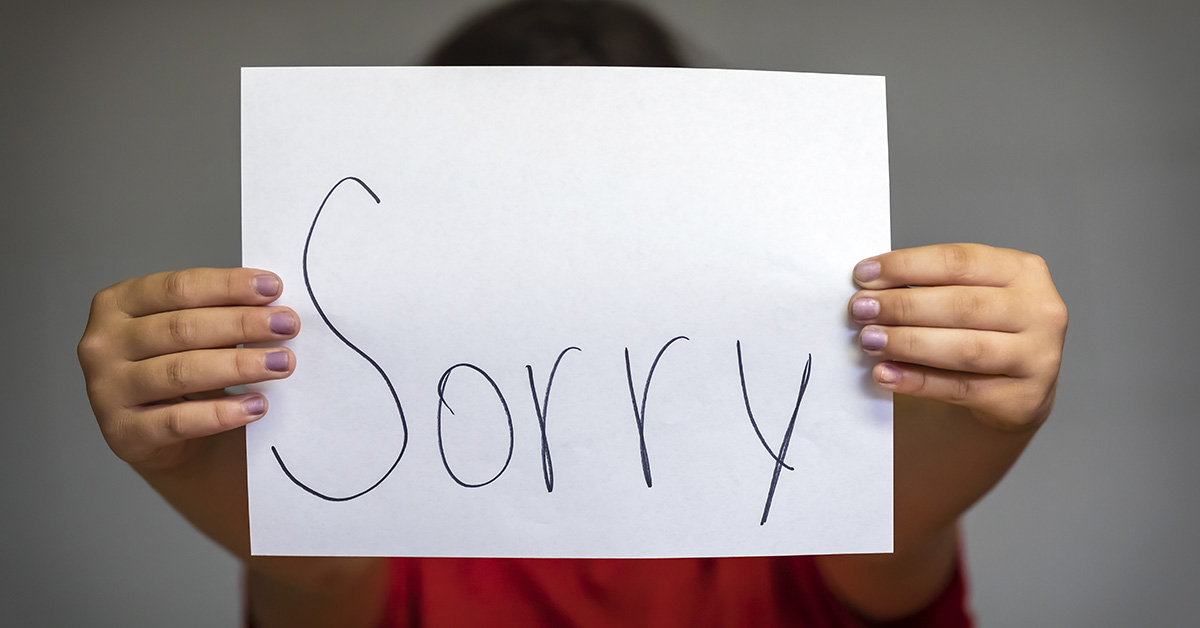Apologies are not easy. Many of us find them awkward and embarrassing, and trying to give one makes us really, really nervous. Rightfully so – making a bad apology is not as useful as making a heartfelt, genuine one. A good apology can restore balance and improve relationships. The problem is that most of us don’t actually know how to apologize properly. Understanding what an apology should (and should not) include will drastically improve your interpersonal relationships. This is how you do it.
How To Apologize Like A Pro
Research shows that a heartfelt, genuine apology has tremendous healing power. A good apology can be like emotional ‘super glue.’ They promote the bonding and healing of relationships even after thoughtless behavior or mistakes have been made. (1) The question is, how does one apologize effectively? What actually constitutes a good apology versus a bad one? A sincere apology should include these three things:
- An admission of responsibility
- An expression of regret, and
- A request for forgiveness.
Step One: Admit You Were Wrong
We all hate to admit it, but sometimes we are wrong. Regardless of how you feel, your ego, or anything else, you hurt someone else. The first step in a good apology is owning up to that. The apologizer should take ownership of the mistake and feel sincerity towards the other person. People should come to the apology with a desire to make things right and not use this as an opportunity to point fingers. Taking ownership and recognizing that you did something wrong is key in conveying that you are sorry.
A key point in this is details. An “I’m sorry I hurt you” is not owning up to what you did. Get specific. Chances are, you already know and understand what you did and/or said to hurt that person. Be specific with your admission. If you aren’t sure, start apologizing for hurting them and be clear that you regret that (more on this momentarily). Ask them for more details about how you hurt them so you can better understand what you did wrong.
Step Two: Express Regret
A heartfelt, genuine apology involves the wrongdoer taking responsibility and accepting total responsibility for their actions. It is a skill to be able to apologize for both small misunderstandings as well as larger issues. The wrongdoer should express how they feel remorse over their action or inaction and make it clear that they are sorry for what occurred.
If someone gave you an apology that was simply “sorry that I hurt you” or “sorry I did xyz” without expressing remorse, is it really an apology? If you genuinely care about that person and that you hurt them, expressing remorse for what you did or said and how you hurt them should be the easiest part. Ensure you communicate to them that you feel terrible about the whole situation. This makes your apology more genuine.
Read: 7 Signs You’re Suffering From Acid Reflux and How to Fix It
Step Three: Ask For Forgiveness
So you’ve said sorry and expressed remorse for hurting that person. Now, you need to ask for forgiveness and devise a strategy with them so that it won’t happen again. Some cases are more straightforward. For example, you backed your parent’s car into a pole. Simple solution: You will pay more attention when reversing the car from now on. When it comes to more complex situations, such as your partner feeling ignored by you at parties, this may require a more nuanced plan. You will need to ask your partner what they need from you in social situations. Chances are, it’s not actually that difficult. Perhaps they just want you to check in on them more frequently or want you to spend more time dancing with them then chatting with people at the bar. You will never know until you ask.
Six Components That Make Up A Real Apology
Recent research has evaluated six components that make up more of a more heartfelt and genuine apology. The importance of taking time to ensure all components are present when delivering an apology is key to conveying it in a meaningful way. Although there is no universal formula for apologizing, the research has identified the most important elements of an effective apology, which can help individuals craft more successful ones over time. (2)
In their book Sorry, Sorry, Sorry: The Case For Good Apologies, co-authors Marjorie Ingall and Susan McCarthy get more specific with it and break down the six steps for you to follow the next time you have to apologize to someone. They are as follows (3):
- Say you’re sorry. Not that you “regret,” not that you are “devastated.” Say you’re “sorry.”
- Say what it is that you’re apologizing for. Be specific.
- Show you understand why it was bad, take ownership, and show that you understand why you caused hurt.
- Don’t make excuses.
- Say why it won’t happen again. What steps are you taking?
- If it’s relevant, make reparations: “I’m going to pay for the dry cleaning. Just send the bill to me. I’m going to do my best to fix what I did.”
Regardless, it may take some time for that person to rebuild their trust in you. Your parents may remain on edge about loaning you the car for a while. While your partner may have forgiven you, they will pay extra attention to how you conduct yourself at the next party. After all, apologies without behavior change to follow them up are just empty words. Once you’ve proven to that person that you meant what you said, your apology will be truly accepted, and you will move forward stronger than before.
Keep Reading: Having trouble sleeping? Here’s how to fall asleep in just 1 minute

